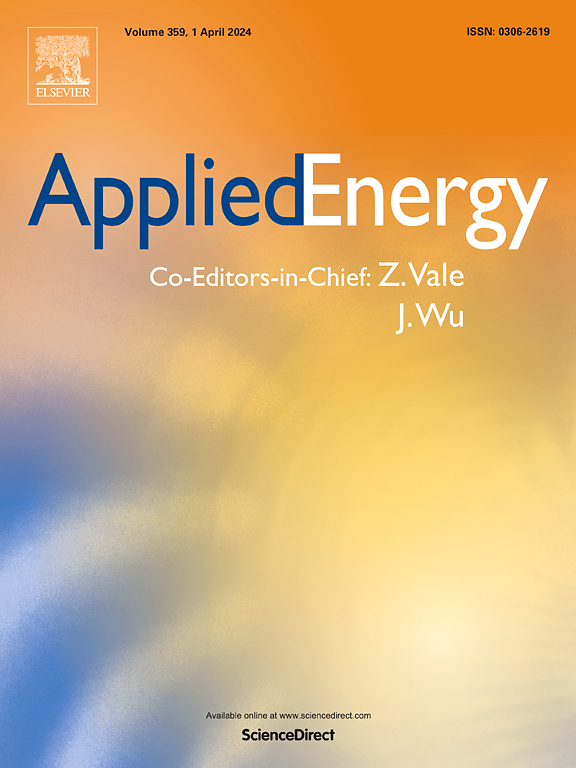基于数据驱动与机理模型的锂离子电池健康状态评估与膝点识别
IF 11
1区 工程技术
Q1 ENERGY & FUELS
引用次数: 0
摘要
准确的健康状态(SOH)估计和膝关节点识别对于优化电池性能和生命周期管理至关重要。提出了一种基于改进newton - raphson优化支持向量回归算法和自适应增强算法(INRBO-SVR-AdaBoost)相结合的SOH估计方法,以及基于最大垂直距离法的考虑失效阈值的膝点识别方法。首先,对标准NRBO算法进行了三处改进,提高了算法的全局搜索能力和收敛速度,使支持向量回归法能够获得最优参数;然后,将AdaBoost算法与insbo - svr方法相结合,提高SOH估计精度;实验结果表明,与其他方法相比,INRBO-SVR-AdaBoost方法具有更高的SOH估计精度,均方根误差和平均绝对误差分别小于0.89%和0.75%。其次,在准确估计SOH的基础上,构建了双指数与二阶多项式相结合的经验模型(SOHEM),计算了不同失效阈值下SOHEM与SOH线性退化曲线之间的最大垂直距离(VDmax,LCD);通过计算不同失效阈值下VDmax、LCD与线性拐点曲线之间的最大垂直距离(VDmax、LKC),确定最终拐点。实验结果表明,所识别的膝关节点误差在46个周期以内,膝关节点识别精度达到90%以上,具有较强的灵活性和精度。提出的高精度SOH估计方法和柔性膝点识别方法对电池寿命预测和退役管理具有重要的指导意义。本文章由计算机程序翻译,如有差异,请以英文原文为准。
State-of-health estimation and knee point identification of lithium-ion battery based on data-driven and mechanism model
Accurate state-of-health (SOH) estimation and knee points identification are crucial for optimizing battery performance and lifecycle management. An SOH estimation method combining an improved Newton-Raphson-based optimizer algorithm for optimizing support vector regression and an adaptive boosting algorithm (INRBO-SVR-AdaBoost) is proposed, as well as a knee point identification method considering failure thresholds based on the maximum vertical distance method. Firstly, three improvements are introduced to enhance the global search ability and convergence speed of the standard NRBO algorithm, enabling the SVR method to obtain optimal parameters. Then, the AdaBoost algorithm is applied to integrate the INRBO-SVR method, improving SOH estimation accuracy. Experimental results show that the INRBO-SVR-AdaBoost method provides higher SOH estimation accuracy than other methods, with root mean square error and mean absolute error both below 0.89 % and 0.75 %, respectively. Secondly, based on the accurate SOH estimation, an empirical model combining a double-exponential and a second-order polynomial (SOHEM) is constructed, and the maximum vertical distance (VDmax,LCD) between SOHEM and the linear SOH degradation curve is calculated for different failure thresholds. By computing the maximum vertical distance (VDmax,LKC) between VDmax,LCD and the linear knee point curve for different failure thresholds, the final knee point is identified. Experimental results show that the identified knee points have an error within 46 cycles, with the identification accuracy of the knee points reaching at least 90 %, demonstrating strong flexibility and precision. The proposed high-precision SOH estimation method and flexible knee point identification method have significant guiding implications for battery life prediction and retirement management.
求助全文
通过发布文献求助,成功后即可免费获取论文全文。
去求助
来源期刊

Applied Energy
工程技术-工程:化工
CiteScore
21.20
自引率
10.70%
发文量
1830
审稿时长
41 days
期刊介绍:
Applied Energy serves as a platform for sharing innovations, research, development, and demonstrations in energy conversion, conservation, and sustainable energy systems. The journal covers topics such as optimal energy resource use, environmental pollutant mitigation, and energy process analysis. It welcomes original papers, review articles, technical notes, and letters to the editor. Authors are encouraged to submit manuscripts that bridge the gap between research, development, and implementation. The journal addresses a wide spectrum of topics, including fossil and renewable energy technologies, energy economics, and environmental impacts. Applied Energy also explores modeling and forecasting, conservation strategies, and the social and economic implications of energy policies, including climate change mitigation. It is complemented by the open-access journal Advances in Applied Energy.
 求助内容:
求助内容: 应助结果提醒方式:
应助结果提醒方式:


